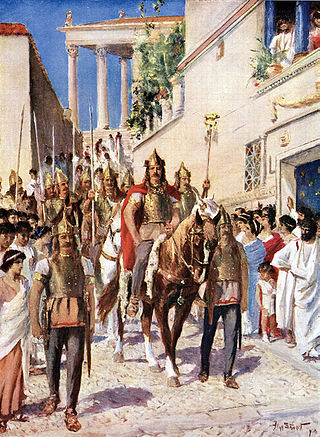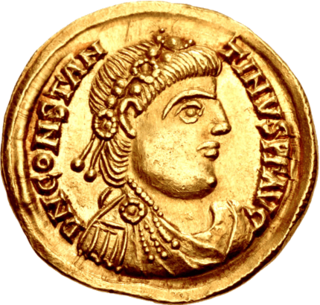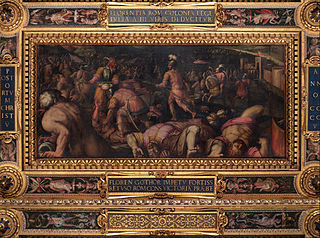
Alaric I was the first king of the Visigoths, from 395 to 410. He rose to leadership of the Goths who came to occupy Moesia—territory acquired a couple of decades earlier by a combined force of Goths and Alans after the Battle of Adrianople.

Honorius was Roman emperor from 393 to 423. He was the younger son of emperor Theodosius I and his first wife Aelia Flaccilla. After the death of Theodosius in 395, Honorius, under the regency of Stilicho, ruled the western half of the empire while his brother Arcadius ruled the eastern half. His reign over the Western Roman Empire was notably precarious and chaotic. In 410, Rome was sacked for the first time in almost 800 years.
The 400s decade ran from January 1, 400, to December 31, 409.
The 390s decade ran from January 1, 390 to December 31, 399

Stilicho was a military commander in the Roman army who, for a time, became the most powerful man in the Western Roman Empire. He was of Vandal origins and married to Serena, the niece of emperor Theodosius I. He became guardian for the underage Honorius. After nine years of struggle against barbarian and Roman enemies, political and military disasters finally allowed his enemies in the court of Honorius to remove him from power. His fall culminated in his arrest and execution in 408.

Wallia, Walha or Vallia, was king of the Visigoths from 415 to 418, earning a reputation as a great warrior and prudent ruler. He was elected to the throne after Athaulf and Sigeric were both assassinated in 415. One of Wallia's most notable achievements was negotiating a foedus with the Roman emperor Honorius in 416. This agreement allowed the Visigoths to settle in Aquitania, a region in modern-day France, in exchange for military service to Rome. This settlement marked a significant step towards the eventual establishment of a Visigothic kingdom in the Iberian Peninsula. He was succeeded by Theodoric I.

Constantine III was a common Roman soldier who was declared emperor in Roman Britain in 407 and established himself in Gaul. He was recognised as co-emperor of the Roman Empire from 409 until 411.

Constans II was the son of Western Roman emperor Constantine III, and served as his co-emperor from 409 to 411. Constans was a monk prior to his father being acclaimed emperor by the army in Britain in early 407, an act of rebellion against the ruling emperor Honorius. He was summoned to Gaul, appointed to the position of caesar (heir) and swiftly married so that a dynasty could be founded. In Hispania, Honorius's relatives rose in 408 and expelled Constantine's administration. An army under the generals Constans and Gerontius was sent to deal with this and Constantine's authority was re-established. Honorius acknowledged Constantine as co-emperor in early 409 and Constantine immediately raised Constans to the position of augustus (emperor), theoretically equal in rank to Honorius as well as to Constantine. Later in 409 Gerontius rebelled, proclaimed his client Maximus emperor and incited barbarian groups in Gaul to rise up. Constans was sent to quash the revolt, but was defeated and withdrew to Arles. In 410, Constans was sent to Hispania again. Gerontius had strengthened his army with barbarians and defeated Constans; the latter withdrew north and was defeated again and killed at Vienne early in 411. Gerontius then besieged Constantine in Arles and killed him.

The fall of the Western Roman Empire, also called the fall of the Roman Empire or the fall of Rome, was the loss of central political control in the Western Roman Empire, a process in which the Empire failed to enforce its rule, and its vast territory was divided between several successor polities. The Roman Empire lost the strengths that had allowed it to exercise effective control over its Western provinces; modern historians posit factors including the effectiveness and numbers of the army, the health and numbers of the Roman population, the strength of the economy, the competence of the emperors, the internal struggles for power, the religious changes of the period, and the efficiency of the civil administration. Increasing pressure from invading barbarians outside Roman culture also contributed greatly to the collapse. Climatic changes and both endemic and epidemic disease drove many of these immediate factors. The reasons for the collapse are major subjects of the historiography of the ancient world and they inform much modern discourse on state failure.

This is a chronology of warfare between the Romans and various Germanic peoples. The nature of these wars varied through time between Roman conquest, Germanic uprisings, later Germanic invasions of the Western Roman Empire that started in the late second century BC, and more. The series of conflicts was one factor which led to the ultimate downfall of the Western Roman Empire in particular and ancient Rome in general in 476.

Radagaisus was a Gothic king who led an invasion of Roman Italy in late 405 and the first half of 406. A committed pagan, Radagaisus evidently planned to sacrifice the Senators of the Christian Roman Empire to the gods, and to burn Rome to the ground. Radagaisus was executed after being defeated by the general Stilicho. 12,000 of his higher-status fighters were drafted into the Roman army and some of the remaining followers were dispersed, while so many of the others were sold into slavery that the slave market briefly collapsed. These Goths later joined Alaric I in his conquest of Rome in 410.
The Gothic wars or Roman–Gothic wars were a long series of conflicts between the Goths and the Roman Empire between the years 249 and 554 AD. The main wars are detailed below.
The Battle of Verona was fought in June 402 by Alaric's Visigoths and a Western Roman force led by Stilicho. Alaric was defeated and forced to withdraw from Italy.
The Battle of Pollentia was fought on 6 April 402 (Easter) between the Romans under Stilicho and the Visigoths under Alaric I, during the first Gothic invasion of Italy (401–403). The Romans were victorious, and forced Alaric to retreat, though he rallied to fight again in the next year in the Battle of Verona, where he was again defeated. After this, Alaric retreated from Italy, leaving the province in peace until his second invasion in 409, after Stilicho's death.

The sack of Rome on 24 August 410 AD was undertaken by the Visigoths led by their king, Alaric. At that time, Rome was no longer the administrative capital of the Western Roman Empire, having been replaced in that position first by Mediolanum in 286 and then by Ravenna in 402. Nevertheless, the city of Rome retained a paramount position as "the eternal city" and a spiritual center of the Empire. This was the first time in almost 800 years that Rome had fallen to a foreign enemy, and the sack was a major shock to contemporaries, friends and foes of the Empire alike.

Uldin, also spelled Huldin is the first ruler of the Huns whose historicity is undisputed.
The siege of Florence took place in 405 or 406 AD during the War of Radagaisus between the Goths and the Roman Empire in Florence.
Olympius was a minister of the Western Roman Empire, in the court of the emperor Honorius. Olympius orchestrated the fall and execution of the capable general Stilicho, who had effectively been ruling the Western Roman Empire as regent of Honorius for over twelve years.

The War of Radagaisus was a military conflict in northern Italy in the period 405–406. This conflict was caused by the invasion of Radagaisus in 405. He invaded the Western Roman Empire with a huge population shortly after the empire had ended a war with the Visigoths. Due to the size of Radagaisus' army, it required a tremendous effort by the Romans to avert this danger. Commander-in-chief Stilicho was closely involved in the preparations that were made and personally directed the army's operations.

The revolt of Alaric I was a military conflict between the Roman Empire and a rebel army, probably composed mainly of Goths. This war consisted a number of armed conflicts in the period between 395 and 398, interspersed with periods of negotiations and sometimes even cooperation. During this war, the western and eastern parts of the Roman Empire did not always joint together because of conflicting interests. The protagonists in this conflict were the West-Roman commander-in-chief Stilicho, the Eastern-Roman prefect Rufinus, his successor Eutropius and Alaric I. The latter was an elected Gothic military leader and monarch, and later considered one of first Visigothic kings.















